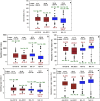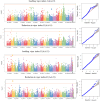Genome-wide association study reveals the QTLs and candidate genes associated with seed longevity in soybean (Glycine max (L.) Merrill)
- PMID: 40604443
- PMCID: PMC12219832
- DOI: 10.1186/s12870-025-06822-1
Genome-wide association study reveals the QTLs and candidate genes associated with seed longevity in soybean (Glycine max (L.) Merrill)
Abstract
Background: Soybean is challenged with a problem of poor seed longevity, a complex trait and key target for breeding. Therefore, understanding the genetic basis of seed longevity is of great significance for mining favorable genes and prolonging the seed life. A genome-wide association study (GWAS) was conducted to understand the genetic background of seed longevity over two ageing methods (natural ageing and accelerated ageing) and seasons.
Results: This study evaluated seed longevity traits in a panel of sixty diverse soybean genotypes with different seed coat colors, seed sizes, and agro-morphological traits under natural and accelerated ageing across two seasons. Seed longevity related traits such as seed germination, seedling vigor index-I (SVI-I), seedling vigor index-II (RVI-II), reduction in vigor index-I (RVI-I), and reduction in vigor index-II (RVI-II) were recorded after 12 and 14 months after natural ageing and accelerated ageing during the year 2019 and 2021. Seed germination under natural aging averaged 45.2% (range: 4.8-100%) after 12 months and 38.1% (range: 0.0-90%) after 14 months. Accelerated ageing resulted in germination rates ranging from 0.0 to 80.6% with means of 43.38% and 40.7% in 2019 and 2021, respectively. Significant variability in SVI-I, SVI-II, RVI-I, and RVI-II was observed across genotypes and conditions. GWAS using 29,955 Genotyping-by-sequencing (GBS)-single nucleotide polymorphism (SNP) markers identified 71 significant SNPs linked to seed longevity traits. Chromosomes 1, 4, and 8 harboured common SNPs for seed germination, SVI-I, SVI-II, and RVI-I. QTL hotspots were detected on chromosomes 2 and 8, encompassing multiple SNPs within 189 bp and 19 bp, respectively. Twenty-eight candidate genes were identified, including Glyma20g27840 (encoding a LEA hydroxyproline-rich glycoprotein family) on chromosome 20 for germination and SVI-I, and Glyma08g24630 (encoding ATP-dependent RNA helicase A) on chromosome 8 for germination, SVI-II, and RVI-II. Several candidate genes involved in ROS scavenging, cell regulation, ATP production, metabolism, stress response, and seed development were also associated with seed longevity traits.
Conclusions: The SNPs associated with many longevity related traits and genes in the present study can be used for soybean breeding and functional studies of seed longevity in soybean after validation using linkage mapping or diverse population.
Keywords: Candidate gene; Genome wide association study; Natural ageing of seeds; QTLs; Seed germination; Seed longevity; Seedling Vigor.
© 2025. The Author(s).
Conflict of interest statement
Declarations. Ethics approval and consent to participate: Not applicable; the study is a not a clinical trial. Consent for publication: Not applicable. Competing interests: The authors declare no competing interests.
Figures






Similar articles
-
Identification of hub genes regulating seed germination viability in soybean via comparative transcriptome analysis and WGCNA.BMC Plant Biol. 2025 Jul 3;25(1):861. doi: 10.1186/s12870-025-06833-y. BMC Plant Biol. 2025. PMID: 40610855 Free PMC article.
-
Conditional QTL/QTN mapping for seed width and mining candidate genes based on soybean FW-RIL population.Mol Genet Genomics. 2025 Jun 20;300(1):60. doi: 10.1007/s00438-025-02271-5. Mol Genet Genomics. 2025. PMID: 40540235
-
Candidate gene identification and marker development for seed coat peeling rate in peanut (Arachis Hypogaea L.).BMC Plant Biol. 2025 Jul 25;25(1):959. doi: 10.1186/s12870-025-07007-6. BMC Plant Biol. 2025. PMID: 40713477 Free PMC article.
-
A meta-analysis of genome-wide association studies to identify candidate genes associated with feed efficiency traits in pigs.J Anim Sci. 2025 Jan 4;103:skaf010. doi: 10.1093/jas/skaf010. J Anim Sci. 2025. PMID: 39847436 Free PMC article.
-
The clinical effectiveness and cost-effectiveness of enzyme replacement therapy for Gaucher's disease: a systematic review.Health Technol Assess. 2006 Jul;10(24):iii-iv, ix-136. doi: 10.3310/hta10240. Health Technol Assess. 2006. PMID: 16796930
References
-
- Zhang X, Mengge X, Aiman H, Jiejie K, Junyi G, Xiaohong H, Zhao T. Seed storability of summer-planting soybeans under natural and artificial aging conditions. Legume Res. 2018;42(2):250–9. 10.18805/lr-404.
-
- Usha TN, Dadlani N. Evaluation of seed vigour in soybean (Glycine max). Legume Res. 2015;38(3):308–12. 10.5958/0976-0571.2015.00115.0.
-
- Zhou W, Chen F, Luo X, Dai Y, Yang Y, Zheng C, Yang W, Shu K. A matter of life and death: molecular, physiological, and environmental regulation of seed longevity. Plant Cell Environ. 2020;43(2):293–302. 10.1111/pce.13666. - PubMed
MeSH terms
Grants and funding
LinkOut - more resources
Full Text Sources

